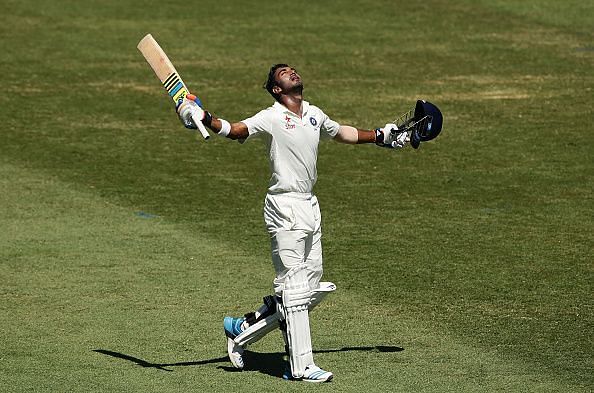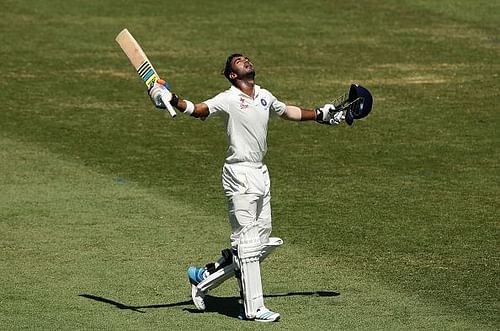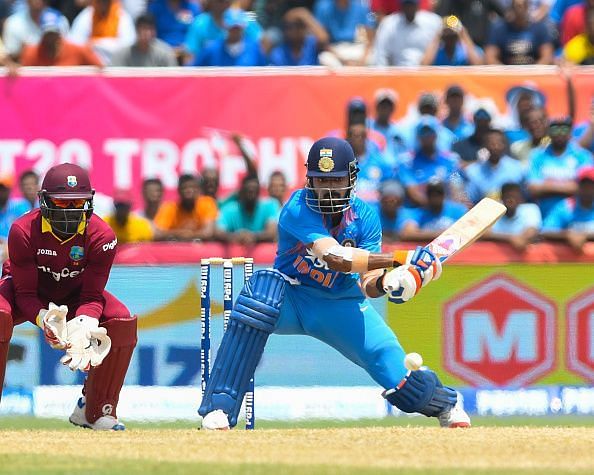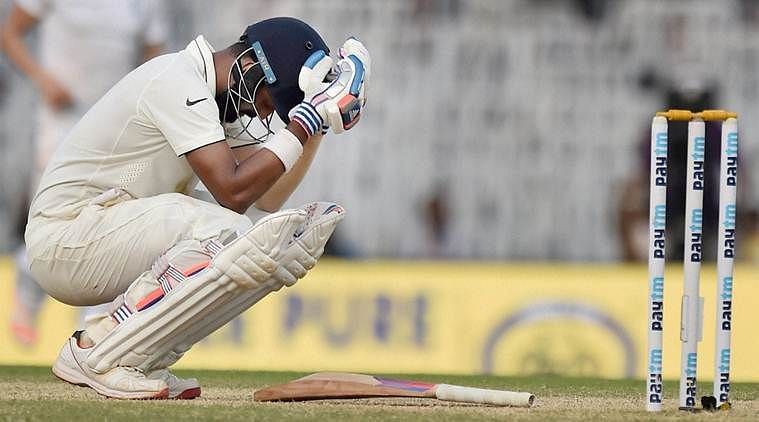
Under the SKanner: KL Rahul

A wicket-keeper until the Under-19 level – he is still very useful in that position – Rahul pleased, among others, all the prominent personalities to have represented India from his state when he showed early signs of growth at the domestic level.
Rahul stands tall at the crease and has an adaptable game which makes him suitable across formats.
An impressive ability of lighting up a limited-overs match with a frisson of excitement with his timely big hits mingled with the calm temperament of a Test opener seeing out the hard, new ball, his brief international journey has brought its share of promise and hefty expectations.
Having debuted in Melbourne on the tour of Australia in 2014, a packed and performing set of batsmen meant Rahul occupied the unusual spot of number six. He fell cheaply and completed a forgettable first Test when pushed up to three in the second innings, trapped by spin and pace alike. In the match that followed, Rahul was given his familiar position of an opener and he reminded critics why he was so highly rated in India and that batting confidently was an innate quality in him. A hundred in Sydney against the likes of the fearsome pair of Mitchell Starc and Josh Hazlewood calmed Rahul down. He continued the trend of smashing centuries on the opponent’s soil when he smacked one each in Sri Lanka and West Indies in 2015 and 2016, respectively. When England arrived in late 2016, Rahul hit a career-best, though regretful, 199 in Chennai.
Here we measure Rahul’s strengths and weaknesses.
Strengths

1. Adaptability across formats
Rahul brings with himself the rare quality of adaptability across all three formats. When opening in Tests, he sees off the threat of the swinging new ball while patiently awaiting the loose delivery to find the fence.
He is still at the crease with nimble foot movement and away from the malady of attacking too early which affects most modern batsmen.
Rahul achieved the envious feat of a century each in all three of his first tours, and impressed experts with a stable mindset to go with an orthodox technique of a Test batsman.
In ODIs and T20s, Rahul boasts of a game which has served him with success in his limited appearances in the blue shirt. In his debut series against Zimbabwe in 2016, Rahul became the first Indian to crack a century on ODI debut and followed that up with 63 in the third ODI.
He uses his feet effectively against spinners and can use the long handle to produce great results.
When offered pace and width, Rahul cuts elegantly to dispatch the ball to the boundary, while if the bowler is too full, he brings out the fluent cover drive beautifully. Equally proficient on either side of the wicket, straying onto the pads can also be punishment.
Rahul has all the shots in the book - the cover drive, the flick, the pull, the orthodox sweep and the reverse-sweep.
With a steady head position and an endearing game, Rahul can be rightly tagged as the next poster boy of Indian cricket after his sparkling 110* in a T20 against West Indies at Florida where India were in a pursuit of a mammoth 246.
Though India fell excruciatingly short of a win – they lost by 1 run – that audacious knock comprising 12 fours and 5 sixes warned the world of what was to come.
2. Neither perturbed by pace nor moved by spin
Having tackled the accurate pace of Mitchell Starc and Josh Hazlewood in Australia, the spin of Rangana Herath in Sri Lanka and the slowing tracks of the West Indies, Rahul has displayed a dour character and remained unperturbed by either extra pace or excessive turn for the spinner.
Time and experience have taught him to judge the pitch and the situation well, besides making him staunch against both rapid pace as well as startling spin.
On the turning pitches at home against England and Australia across the 2016/17 season, Rahul enjoyed the challenge posed by spinners Moeen Ali, Adil Rashid and Nathan Lyon, whom he defended when required and attacked when comfortable.
A major feature of the lengthy knocks he plays is his composed batting, which suits both types of bowling.
On all three occasions that Rahul reached fifty in Test cricket, he took his it a step further by converting them to hundreds – all of them away from home.
3. Best answer to an inconsistent Shikhar Dhawan
Right before the commencement of Rahul’s debut series in Australia in 2014/15, Shikhar Dhawan had begun showing signs of inconsistency in the longest format.
He had been dropped for the final two Tests in England on India’s previous foreign assignment, and again found himself on the bench in the Sydney Test in which Rahul got his maiden ton.
Both injuries and poor form hurt Dhawan’s cause as he soon lost the faith of the selectors and the team management.
Though he too scored centuries in Sri Lanka and West Indies, Dhawan contributed only sporadically otherwise and failed to match his Test match game with the success he touched in one-day cricket.
India were in need of a consistent opener matching the skills of Murali Vijay, and Rahul answered the call. With his noticeable performances, he grabbed the opportunity with both hands and as a result, Dhawan was dropped from the Test side, limiting his role to an injury replacement.
Weaknesses

1. The short ball at good pace
Though Rahul faced Mitchell Starc and company with élan in their own backyard, the home pacers did not miss out on peppering him with short balls and bouncers, thus exposing a weakness in Rahul’s game.
Vulnerable to the short stuff, they targetted him with chin music aplenty on tracks designed to aid rapid fast bowling.
He jostled at deliveries aimed at his body and was found scampering to the balls that hurried at him off the surface.
As a result, despite being well set on the pitch and having adapted to the conditions splendidly well for a youngster, Rahul fell tamely while hooking Starc after his century in Sydney.
The bulky left-armer pitched it short with great pace and Rahul got a bottom edge, which skied the ball towards the bowler.
The pattern of dismissal repeated itself in Sri Lanka as well as against the West Indies when Rahul misjudged the pace of the ball and got a leading edge towards the bowler.
In order to be further successful at the art of batting, Rahul must overcome this weakness sooner rather than later, as India have a tour to South Africa lined up during the winter of 2017, where he can fully expect a repetition of bouncers and short balls aimed at him.
2. Persistent injuries
After playing in the West Indies and the Kanpur Test against New Zealand the previous home season, Rahul sat out for the rest of the series with a hamstring injury.
India were already struggling with an out of form Shikhar Dhawan and Rahul’s ill-timed injury meant the former was back into the eleven for the second Test in Kolkata.
As if Rahul’s injury was not enough, Dhawan then broke his finger and was replaced by Gautam Gambhir for the third Test in Indore.
Upon returning to the side for the second Test against England at Visakhapatnam, Rahul suffered an injury to his left forearm while fielding. That ruled him out of the Mohali Test that followed.
When he joined the side again for the solitary Test against Bangladesh and four matches against Australia, he hurt his shoulder in the first Test at Pune. Though Rahul valiantly battled on throughout the series, medical advice prevented him from participating in the Champions Trophy in June and the subsequent ODIs in West Indies.
Named in the squad to play three Tests in Sri Lanka, Rahul was down with fever and missed the first Test in Galle while not travelling with the team and remaining in Colombo. Persistent injuries not only harm India’s cause but also hurt Rahul’s progress as a maturing batsman at the top.
3. Needs to convert more starts into big ones
Though Rahul converted his first three half-centuries into Test hundreds and his maiden ODI and T20 fifty into a hundred, there are questions regarding the number of times he has failed to convert a decent start into a substantial contribution for his country.
In his last Test series, at home against Australia, Rahul breached fifty on six occasions but missed out on scoring a hundred every time.
His highest score remained 90 at his home ground in Bangalore, though he remained unbeaten on 51 in Dharamsala. Four times he fell while attacking spin while the dangerous pace of Pat Cummins twice accounted for him.
In Kanpur against New Zealand, Rahul threw away twin starts to fall to spin for 32 and 38; in Mumbai against England, Moeen Ali had him bowled for 24 after Rahul attempted an adventurous cover drive against the turn.
For Rahul to continue the legacy of great role models from Karnataka, he must iron out his weaknesses and transform himself into a consistent and fit opener, which, if he does soon, will be of little surprise considering the potential he possesses.